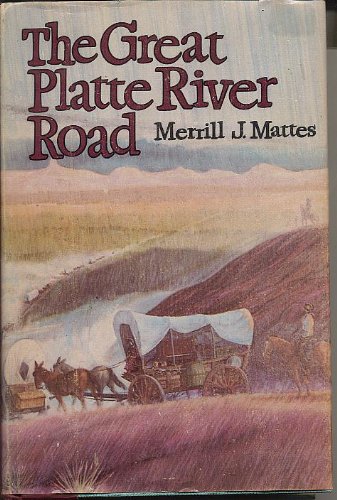Merrill J. Mattes, The Great Platte River Road: The Covered Wagon Mainline via Fort Kearny to Fort Laramie (1960)
 From the description: The Great Platte River Road through Nebraska and Wyoming was the grand corridor of America’s westward expansion. A number of famous trails converged in the broad valley of the Platte, forming a kind of primitive superhighway for the great covered wagon migration from 1841 to 1866. From jumping-off places along the Missouri River—notably the Omaha-Council Bluffs, St. Joseph, and Kansas City areas—the emigrant throngs came together at Fort Kearny, Nebraska. Although they continued on to South Pass, Wyoming, and beyond, this book focuses on the feeder routes and the more than three hundred miles between Fort Kearny and Fort Laramie. The Great Platte River Road looks at border towns, trail routes, river crossings, stage stations, military posts, and such landmarks as Chimney Rock and Scott’s Bluff. It goes far beyond geography and Indian encounters in revealing cultural aspects of the great migration: food, dress, equipment, organization, camping, traffic patterns, sex ratios, morals, manners, religion, crime, accidents, disease, death, and burial customs.
From the description: The Great Platte River Road through Nebraska and Wyoming was the grand corridor of America’s westward expansion. A number of famous trails converged in the broad valley of the Platte, forming a kind of primitive superhighway for the great covered wagon migration from 1841 to 1866. From jumping-off places along the Missouri River—notably the Omaha-Council Bluffs, St. Joseph, and Kansas City areas—the emigrant throngs came together at Fort Kearny, Nebraska. Although they continued on to South Pass, Wyoming, and beyond, this book focuses on the feeder routes and the more than three hundred miles between Fort Kearny and Fort Laramie. The Great Platte River Road looks at border towns, trail routes, river crossings, stage stations, military posts, and such landmarks as Chimney Rock and Scott’s Bluff. It goes far beyond geography and Indian encounters in revealing cultural aspects of the great migration: food, dress, equipment, organization, camping, traffic patterns, sex ratios, morals, manners, religion, crime, accidents, disease, death, and burial customs.
All of the above is true. As a reviewer noted, “Not necessarily an exciting read ‘story-wise,’ but very good for historical research purposes and for learning the layout of the land and its early pioneers.” I first learned about Mattes from Irene Paden’s book. He was one of their local guides in Nebraska in the 30s and 40s. But while Mattes is very knowledgeable about the trail, his style is to quote emigrant diaries excessively, and often redundantly. As a result, the book can be rather plodding. And clocking in at over 500 pages, that’s a lot of plodding.
One interesting point to note is Mattes’s place on the continuum of emigrant trail sleuths. The Padens tried to retrace the route in the 40s, and often noted the current communities and roads at various locations. Twenty years later, Mattes was doing the same thing, noting the increase in private farmland and U.S highways and the very few places the wagon tracks were still visible. Today, of course, we would talk of the Interstates.